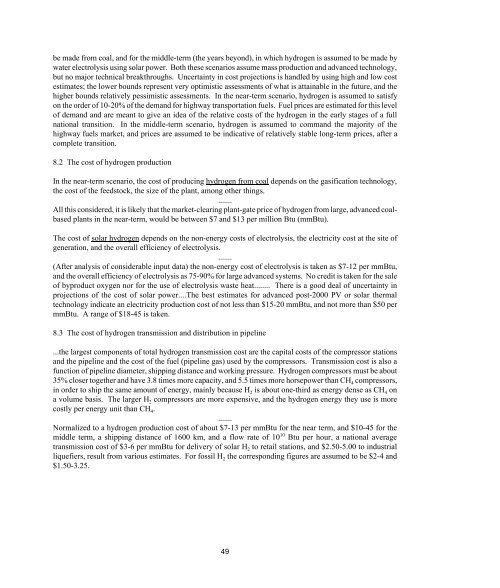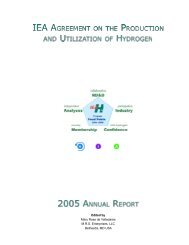Technology Status of Hydrogen Road Vehicles
Technology Status of Hydrogen Road Vehicles
Technology Status of Hydrogen Road Vehicles
You also want an ePaper? Increase the reach of your titles
YUMPU automatically turns print PDFs into web optimized ePapers that Google loves.
e made from coal, and for the middle-term (the years beyond), in which hydrogen is assumed to be made by<br />
water electrolysis using solar power. Both these scenarios assume mass production and advanced technology,<br />
but no major technical breakthroughs. Uncertainty in cost projections is handled by using high and low cost<br />
estimates; the lower bounds represent very optimistic assessments <strong>of</strong> what is attainable in the future, and the<br />
higher bounds relatively pessimistic assessments. In the near-term scenario, hydrogen is assumed to satisfy<br />
on the order <strong>of</strong> 10-20% <strong>of</strong> the demand for highway transportation fuels. Fuel prices are estimated for this level<br />
<strong>of</strong> demand and are meant to give an idea <strong>of</strong> the relative costs <strong>of</strong> the hydrogen in the early stages <strong>of</strong> a full<br />
national transition. In the middle-term scenario, hydrogen is assumed to command the majority <strong>of</strong> the<br />
highway fuels market, and prices are assumed to be indicative <strong>of</strong> relatively stable long-term prices, after a<br />
complete transition.<br />
8.2 The cost <strong>of</strong> hydrogen production<br />
In the near-term scenario, the cost <strong>of</strong> producing hydrogen from coal depends on the gasification technology,<br />
the cost <strong>of</strong> the feedstock, the size <strong>of</strong> the plant, among other things.<br />
.......<br />
All this considered, it is likely that the market-clearing plant-gate price <strong>of</strong> hydrogen from large, advanced coalbased<br />
plants in the near-term, would be between $7 and $13 per million Btu (mmBtu).<br />
The cost <strong>of</strong> solar hydrogen depends on the non-energy costs <strong>of</strong> electrolysis, the electricity cost at the site <strong>of</strong><br />
generation, and the overall efficiency <strong>of</strong> electrolysis.<br />
.......<br />
(After analysis <strong>of</strong> considerable input data) the non-energy cost <strong>of</strong> electrolysis is taken as $7-12 per mmBtu,<br />
and the overall efficiency <strong>of</strong> electrolysis as 75-90% for large advanced systems. No credit is taken for the sale<br />
<strong>of</strong> byproduct oxygen nor for the use <strong>of</strong> electrolysis waste heat........ There is a good deal <strong>of</strong> uncertainty in<br />
projections <strong>of</strong> the cost <strong>of</strong> solar power....The best estimates for advanced post-2000 PV or solar thermal<br />
technology indicate an electricity production cost <strong>of</strong> not less than $15-20 mmBtu, and not more than $50 per<br />
mmBtu. A range <strong>of</strong> $18-45 is taken.<br />
8.3 The cost <strong>of</strong> hydrogen transmission and distribution in pipeline<br />
...the largest components <strong>of</strong> total hydrogen transmission cost are the capital costs <strong>of</strong> the compressor stations<br />
and the pipeline and the cost <strong>of</strong> the fuel (pipeline gas) used by the compressors. Transmission cost is also a<br />
function <strong>of</strong> pipeline diameter, shipping distance and working pressure. <strong>Hydrogen</strong> compressors must be about<br />
35% closer together and have 3.8 times more capacity, and 5.5 times more horsepower than CH 4 compressors,<br />
in order to ship the same amount <strong>of</strong> energy, mainly because H 2 is about one-third as energy dense as CH 4 on<br />
a volume basis. The larger H 2 compressors are more expensive, and the hydrogen energy they use is more<br />
costly per energy unit than CH 4.<br />
.......<br />
Normalized to a hydrogen production cost <strong>of</strong> about $7-13 per mmBtu for the near term, and $10-45 for the<br />
middle term, a shipping distance <strong>of</strong> 1600 km, and a flow rate <strong>of</strong> 10 10 Btu per hour, a national average<br />
transmission cost <strong>of</strong> $3-6 per mmBtu for delivery <strong>of</strong> solar H 2 to retail stations, and $2.50-5.00 to industrial<br />
liquefiers, result from various estimates. For fossil H 2 the corresponding figures are assumed to be $2-4 and<br />
$1.50-3.25.<br />
49













